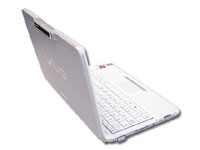Tech Guide: Ultralight notebooks for your business


Expert advice on choosing the perfect business notebook -- from size and weight to the right processor for your needs.
A few grams here, a few grams there. After a while, it adds up to a real pain in the shoulder. Like boxers, notebooks come in a range of weight classes, from 1kg or less to more than 4.5kg. And while it may be tempting to get a larger notebook that seemingly offers more performance for the price, trust us on this -- if you plan to commute with a notebook or spend any time on the road, there are only two types of business notebooks you should consider: ultraportables and thin-and-lights.
Business travellers should consider sub-2kg ultaportables, or 2-3kg 'thin and light' notebooks.
The key specifications for any business traveller choosing a notebook are weight and size. The smallest notebooks, known as ultraportables, generally weigh 2kg or less. They also tend to be less than 2.5cm thick. Thin-and-lights, despite the name, are slightly thicker and heavier, generally weighing from 2kg to 3kg. But they are still very travel-friendly and offer the performance and the features of much larger notebooks, which explains their popularity in business.
The coming of Centrino
The most significant development in this category was the arrival in March 2003 of Intel's Centrino technology. Although integrated wireless gets all the press, the Intel Pentium M processor and its supporting chipset are the real boon for ultraportables and thin-and-lights. Generally, the better the performance, the less battery life you get. The Pentium M delivers excellent performance, yet many models also last around five hours in our tests -- a few with extended batteries come tantalisingly close to lasting a full eight-hour workday. The bottom line is: if you're buying a notebook in one of these classes, start with a Pentium M processor.
Intel's Pentium M processor - particularly the new Dothan part (above), delivers excellent performance, yet remains a power-frugal device.
Size and weight also determine other features to some extent, although that's beginning to change. At one time, you had to settle for a hefty desktop replacement to get the latest and greatest hardware. Now you can find thin-and-lights with memory measured in gigabytes, huge hard drives, cutting-edge graphics and combination CD/DVD burners that all but eliminate the need for the second optical drive found in larger mainstream and desktop-replacement systems.
Doing without drives
The smaller ultraportables, however, still lag in terms of performance and features. For example, they typically lack an internal CD or DVD drive, relying instead on a separate media slice -- a docking unit that you leave behind on the desk most of the time. This was once a big drawback, but nowadays we use fast wireless and Ethernet networks to exchange large files regularly, while occasional tasks that require an optical drive -- such as backing up your hard drive or burning a music mix to a CD -- can be done easily at a desk. At the same time, we're beginning to see ultraportables that manage to include an optical drive, such as Sony's hot VAIO PCG-TR series.
Sony's ultraportable VAIO PCG-TR series combines sub-2kg weight with a built-in optical drive.
No single configuration will be right for every business user, but for most, we recommend a thin-and-light with one of the slower Pentium M processors (you'll save a little money without giving up much performance), 256MB of memory, a 20GB hard drive, a 14.1in. display, an internal combination CD-RW/DVD drive, plus integrated wired and wireless networking. If you want to shed a little weight, you can opt instead for an ultraportable with a media slice.
The price of portability
Unfortunately, thin-and-lights tend to be pricey, so if your budget is tight or you don't travel often, you can get by with a slightly larger mainstream or value system. Getting a quality notebook still means spending between AU$2,000 and AU$4,000, and the sky's the limit from there, with some well-featured Intel Centrino-based systems costing closer to AU$5,000.
As with desktops, when you are buying several, your best bet is to stick with a single vendor and product line. Some corporate notebooks, such as Dell's Latitude and IBM's ThinkPad ranges, use the same components across most or all of the line, which means that you can use the same drives, docking stations and port replicators, and AC adapters with any system -- a big advantage in business. Finally, we recommend that you invest in spare or extended batteries for employees who regularly travel abroad.